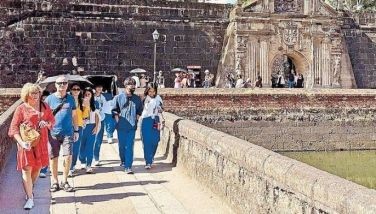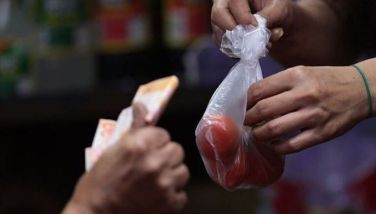Teenager, 19 others crucified in Central Luzon
SAN FERNANDO, Pampanga – Eight men, including a 47-year-old main “Kristo,” were crucified in a small village here, as did at least 12 others, among them a 15-year-old boy, elsewhere in Central Luzon on Good Friday, as Catholics worldwide commemorated the crucifixion of Jesus Christ.
Devout Catholic Ruben Enaje, the main “Kristo,” donned a crown of thorns as he put himself through the agonizing ordeal of being nailed to the cross – for the 22nd time.
Enaje underwent this extreme form of penance in Barangay San Pedro Cutud in an annual ritual that attracts devotees as well as local and foreign tourists.
An estimated 2,000 tourists gathered at around noon Friday, braving the tropical heat to flock to this poor farming community, about an hour’s drive north of Manila, to witness the religious rites.
The re-enactment of the crucifixion of Christ is part of a bloody annual spectacle that shocks outsiders in this devoutly Catholic nation. Although this year, tourism officials said the crowd was less than the 30,000 they expected to witness the crucifixions in San Pedro Cutud.
“I suppose the crowd was dispersed since crucifixions in two other barangays, Sta. Lucia and San Juan, were also promoted,” Billy Danan of the media productions unit of the city government here told The STAR.
He also said that of the 11 men slated to re-enact the crucifixion in San Pedro Cutud, only eight showed up. One of them was Enaje, who again played the role of Jesus Christ during the Via Crucis, or the Stations of the Cross.
Danan said five others were crucified earlier in the day in Sta. Lucia and another three in San Jose.
In neighboring Bulacan, police said four others were nailed to the cross in Barangay Kapitangan, Paombong, including a 15-year-old boy.
Neighbors costumed like Roman centurions dragged Enaje and the other penitents through the village streets toward a barren hill where three wooden crosses and a large crowd of tourists awaited.
Enaje screamed in agony as seven-inch metal nails were driven into his palms and feet as he lay spread-eagled on the cross, which was then hauled upright.
The wooden contraption stood for about five minutes before it was taken down and the nails pulled out. The process was repeated for the other volunteers.
Hours ahead of the ceremony, scores of local men whipped themselves bloody with strips of bamboo attached to strings to atone for their sins.
The dominant Catholic Church frowns on these extreme practices and the health department has warned the penitents to take anti-tetanus shots first and to sterilize their equipment.
“The Church does not recommend it because (it) is against self-flagellation,” said Fr. Norman Vitug, the local parish priest.
“Of course when we express our faith to the Lord the Church does not want us to hurt ourselves for us to experience the love of God. But we cannot question somebody’s faith,” Vitug said.
“It’s just an expression of their faith. We do not lead their lives so we do not know what happens to them while experiencing that, so we might as well respect it,” the priest added.
The crucifixions are organized by the village council, with help from the national government’s tourism department, said barangay official Leonard David.
The order of the crucifixions was done “according to seniority,” with Enaje first because he had done it the most times, David added.
At a nearby tent, doctors examined the penitents before and after the bloody crucifixions.
Health Secretary Francisco Duque said that since it was hard to discourage “flagellants from whipping their own flesh, the best penitents can do is ensure that their whips are well-maintained.”
“We are not trying to go against the Lenten tradition here because whipping has already become some form of atonement for sins for some of us,” Duque said.
“But this advice is important to make sure that no one will land in the hospital due to tetanus or other infections that penitents might get in the process.”
Despite the possible health hazards of this most extreme display of penance, Enaje vowed not to stop thanking God for sparing his life when he fell from the third floor of a building he was painting in Tarlac 22 years ago.
On the one occasion he skipped it eight years ago, Enaje said he was struck down with stomach ulcers and his wife was taken ill.
“It is painful and difficult. But I will continue doing this for as long as I can. This is my pledge to God,” the father of four said, as he prepared his ceremonial garb at his modest wooden home. – Ding Cervantes
- Latest
- Trending

































